Want to defend Capitol Hill? The Pike/Pine battle, it turns out, begins with PDF files.
This proposal for changes to zoning and the rules that govern development in the Pike/Pine corridor will be presented tonight at a public meeting hosted by the city council.
WHAT: Pike/Pine Conservation Study Open House
WHEN: 5:30-7:30p Tuesday, Oct. 14th
WHERE: Seattle Central Community College in Room BE 1110
The proposal document and the two studies that accompany it are full of interesting takeaways and datapoints about the Pike/Pine environment. Kind of cool to read such an in-depth study of an area you walk through every day and for the wonk inside us all, some things to think about when it comes to efforts to preserve things like gay or bohemian culture via the process of city government bureaucracy. I’ve done what I can to cull the best stuff and some important points but — if you take the time to look at the documents yourself — you’ll see that it’s too big a job for any one person. Hopefully a few neighbors can pitch in and share what they find in the comments.
Here are the topline proposal goals:
- Continue to promote new mixed use and residentially‐oriented development as intended under the original provisions of the overlay;
- Expand the scope of the overlay to promote new development that is more compatible in scale with existing conditions in the area;
- Provide incentives to retain “character structures” ‐‐ buildings that are 75 years old or older‐‐as part of new development
- Increase opportunities and flexibility to encourage the continued use of existing buildings
- Promote conditions that allow small, diverse local businesses to continue to operate in the area; and
- Provide incentives for retaining existing art and cultural uses and attracting similar new activities to the area.
And here are the technical points on zoning, etc. that would have to be made to enable the above goals:
DRAFT Director’s Report and Recommendations 1
- Rezone the NC3 areas within the current boundaries of the overlay to a pedestrian zone designation (NC3P), while retaining current height districts.
- Adjust the boundaries of the Capitol Hill Station Area Overlay District to exclude areas that overlap with the Pike/Pine overlay to eliminate redundant and potentially conflicting regulations.
- Designate E. Pike/Pike Street and E. Pine/Pine Street, which currently require commercial uses at street level, as principal pedestrian streets, as well as segments of 10th, 11th, and 12th Avenues east of Broadway and north of Pike Street, which currently do not require street level uses.
- Expand the boundaries of the Pike/Pine Overlay District to include existing NC3P and NC3 zoned areas in the Pike/Pine neighborhood along Broadway and east of Broadway and south of E. Pike Street.
- Establish a maximum lot size limit for all new development and a maximum limit on structure width for new structures with frontage along Pike and Pine Streets.
- Provide incentives through exemptions from floor area calculations and/or limits on non‐residential use to:
o retain existing character structures and “envelope” portions of existing character structures on a development lot;
o encourage development on small lots of 8,000 square feet or less;
o include space for small commercial uses at the street level of structures;
o include arts facilities in existing structures and new projects; and
o maintain economic viability of character structures by allowing the maximum range of uses to fully occupy these structures and limited additions to these structures.- Allow a height exception for projects that retain existing character structures and portions of existing character structures on a development lot.
- Limit street frontage width of street level uses in new structures on Pike and Pine Streets.
- Restrict certain types of signs that are incompatible with the local business character of the Pike/Pine area.
There are also some cool maps, measurements and analysis in the supporting studies to provide background for the recommendations. It’s an interesting, mostly empirical walk through Pike/Pine.
Here’s the dataset that frames the entire discussion — by 2030, Pike/Pine is projected to be home to 66% more people than it is now with only a 38% increase in housing units. Add a 45% growth in jobs in the area and you end up with a mixed-use explosion.
- Historically, a high percentage of the housing units in the Pike/Pine neighborhood were rental: 97% as of 1990, and 90% as of the 2000 census. However, much of the new housing being built in the district is owner-occupied.
- Like Seattle as a whole, the median age for the Pike/Pine neighborhood is fairly young: 31.2 years. The percentage of elderly (those over 65), at 7%, is low for the city, emphasizing its youth-oriented flavor. A small average household size (1.37 persons vs. 2.09 for the city overall) reinforces the singles reputation of the neighborhood. Twenty- four percent of residents live below the poverty line.
- Of a total of 278 buildings within the Pike/Pine study area, 165 (59.4%) are more than 85 years old. Forty-six buildings (16.5%) were built between 1923 and 1945, 51 (18.3%) were built between 1946 and 1995, and 16 (5.8%) were built from 1995 to 2007.
- Sixty-five buildings within the study area have been inventoried by the City of Seattle Department of Neighborhoods in its cultural resources survey, and fifty-three of these are identified as potentially of historic value 9. Most of these structures are concentrated on the following streets:
18 buildings on Pine Street
10 buildings on Pike Street (plus 1200 E. Pike Street)
9 buildings on Broadway
5 buildings on 12th Avenue
3 buildings on Melrose Avenue
6 buildings on Union Street - Sixteen buildings have been built between 1995 and 2007. Of these 16 buildings, 14 were entirely residential or residential with ground‐floor retail. Ten of these 14 are condominiums, and three are rental (including one subsidized).
There are a lot of great maps in the study — a few warrant future posts. Here’s one of the coolest — shows the age of buildings in the corridor. The blue buildings are pre-1923, light green indicates 1923-1945, yellow is anything built between ’46 and 1995 and red, everything since. Kind of amazing how much of the area was built pre-’23. Impressive. Check out the study PDFs for better detail.
Another map shows a list of development projects happening in the area and the buildings that fit have characteristics that put them on the target list for future development. Basically, the list includes all of Pike/Pine minus recent development, Cal Anderson and a few patches of non-profit housing.
There are also some surgical changes proposed to address specific issues. For example, how to encourage developers to work with existing structures in the area and not tear everything down.
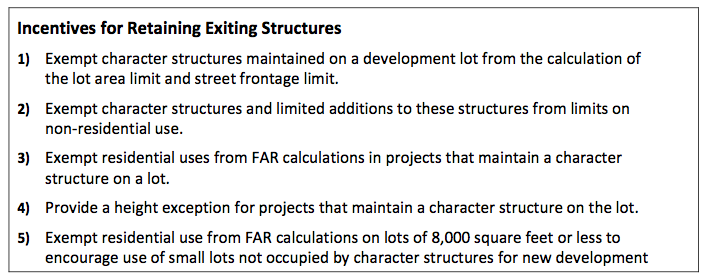 This is cool to see — a solution to encourage designs that incorporate existing buildings:
This is cool to see — a solution to encourage designs that incorporate existing buildings:
To accommodate projects that include an existing structure as part of the development program, the lot area occupied by a character structure would not be included in the calculation of the lot area subject to the lot size limit or in calculations of the width a structure abutting specified street frontages.
Another part of the study focused on the possible impact of an urban planning concept called TDR — transfer of development rights. Here’s an overview of the TDR concept and an interesting, short write-up of a case study about the use of TDR in India. The basic idea of a TDR is encouraging developers to not develop or “under develop” in sensitive areas in exchange for the right and incentives to develop in less sensitive areas. The study determined that extending Seattle’s existing DTR programs to Pike/Pine would not have a positive impact. One reason: When factoring in the amount of land available for development, the city estimates Capitol Hill’s land value to be about $60 per square feet of developable land. That’s about 20% higher than downtown and, I assume, that’s a greater gap than Seattle’s current TDR solutions can handle.
The report’s recommendations for TDR-related efforts focus on longer-term changes to be tackled next year:
• Establish conservation TDR program for Pike/Pine: identify sending and receiving areas (potential rezones) and develop program details.
• Fund landmark designation process for Pike/Pine landmark candidates: nomination, designation, controls and incentives, and designating ordinances (and provide incentives to owners of nominated properties).
• Establish an alternate receiving area for Pike/Pine TDR
• Establish height and bulk incentives for conservation
• Create TDR opportunities for residential developments downtown to broaden the
demand base for TDRs.
• Give Pike/Pine TDRs priority for use, conveying additional benefits on the receiving site to preferentially absorb Pike/Pine TDRs or raise their price relative to other TDRs. (This would require de-emphasizing TDRs for other public benefits in the current program).
• Promote joint renovation and development of adjacent and non-adjacent properties in the Pike/Pine area (essentially an alternative or in-block TDR program).
It’s a lot to digest — will be interesting to hear what kinds of questions and comments come up at the public meeting. In the meantime, I’m interested to know more about what you see in the report and proposals.
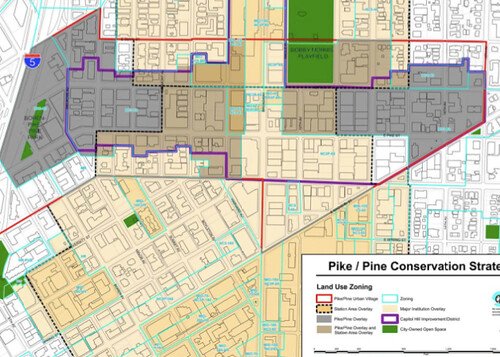


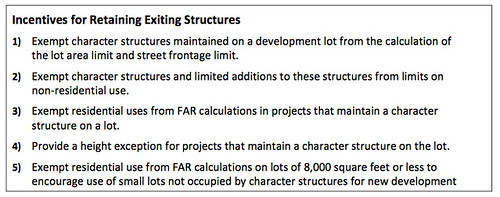

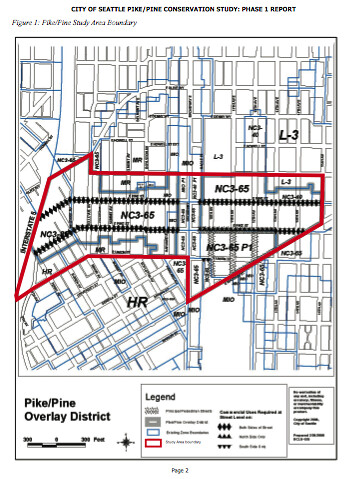




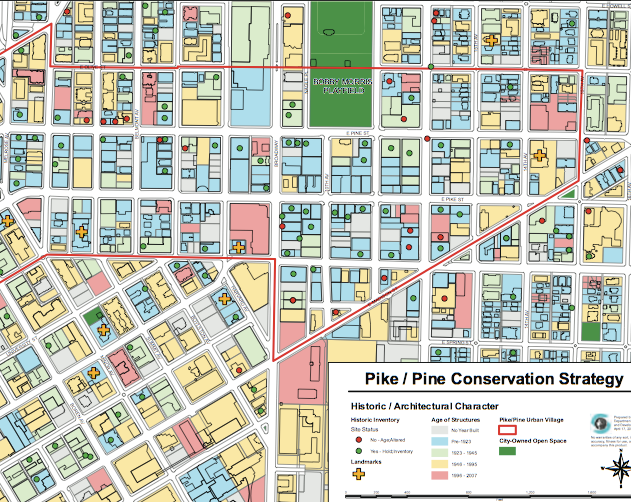
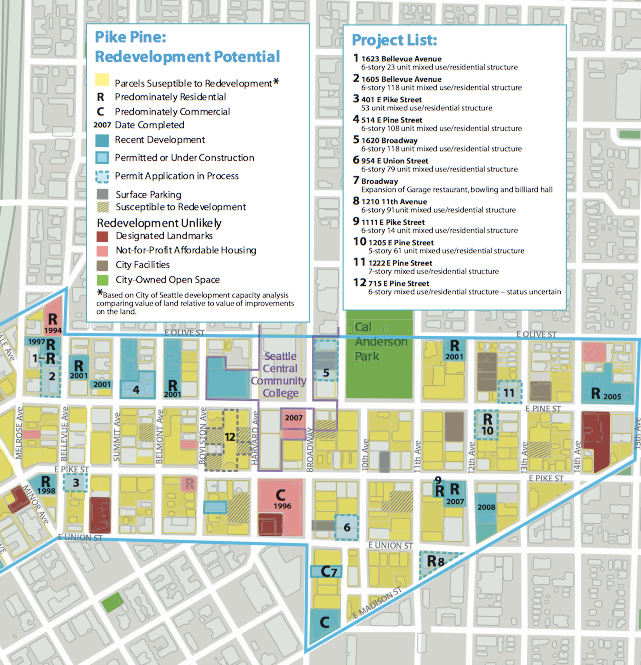
i don’t like fighting but if someone is about to bulldoze my boyfriend imma have to step in….we’ll be there.
cool stuff. do you think we could get them to re-zone 15th as “commercial – non-balloon”?
I think you should propose a helium offset credit program.
A lot my block is pre-1910. There’s no way my building would be able to survive any attempt at preservation and most can’t. They’re just too old and have way too much brick to comply. This is sad. Thanks for the information. I hope more people pay attention to this!